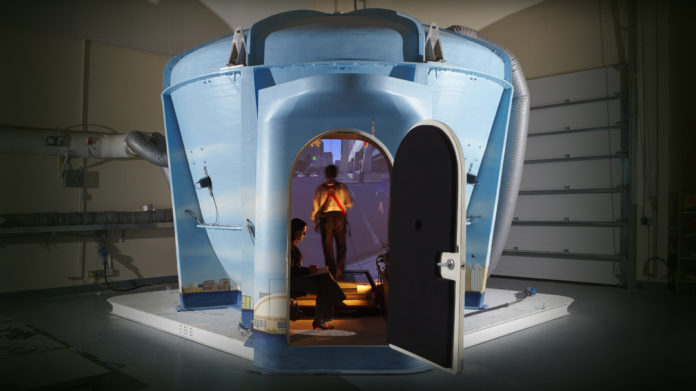Visiting the Challenging Environmental Assessment Lab (CEAL) in downtown Toronto is akin to venturing into a Bond villain’s lair. After the descent by elevator under the Toronto Rehabilitation Institute, you’ll find yourself at the control deck of a massive underground facility. From here, researchers use hydraulic-powered platforms and virtual reality to measure day-to-day hazards in a safe setting.
Instead of doomsday devices concocted under the direction of kitty-petting masterminds, there are engineers, psychologists and therapists making excellent use of state-of-the-art technology to create a safer world.
Dr. Jennifer Campos, CEAL Chief Scientist, is an experimental psychologist whose work focuses on multisensory integration, perception-action coupling, self-motion perception, and locomotor rehabilitation.
Her ambition is to develop a better understanding of the difficulties that the elderly, and people with sensory impairments such as glaucoma, stroke, traumatic brain injury and dementia, encounter in daily scenarios.
Multiple 6m x 6m customizable platforms can integrate with each other or become self-contained labs on the main floor. Take WinterLab, for example, a devilish little box in which researchers can recreate all those nasty winter elements like Arctic winds up to 15 km/h, and slippery walking surfaces that can be raised to match the elevation faced on certain streets.
Here, the team have been studying the gripping strength of popular brands of winter boots, the kind of which you would pick up at your local Canadian Tire. The result? “Oh, they’ve all failed so far. The manufacturers claim they can retain their grip at the standard 7 degrees of elevation, but that’s not what we’ve found,” says Campos.
Given that 21,000 Ontarians visit the emergency room every year because of icy slips and falls, it’s not hard to see the immense value of this research. We have more on WinterLab over here.
StreetLab
Moving along, you’ll notice a domed structure that seems more at home in the world of deep sea diving than environmental safety research. Inside is a treadmill track leading towards a 240-degree projection of a busy street through the eyes of a pedestrian.
The display progresses in tandem with the user as they walk, and realism is enhanced by sensations like bumpy sidewalks and vibrations from passing cars. “Intelligent” vehicles respond to the participant’s movements, and the audio of the scene rises and drops accurately according to the distance of the source.
It all sounds intriguing, but what’s the purpose of a realistic street-walking environment?
“Persons with hearing loss are three times more likely to experience a fall. Our hypothesis is that they have less cognitive reserve to do multiple things simultaneously with age,” says Campos. “Just listening is a lot of effort for these people, and their mobility is compromised when they perform multiple tasks.”
With virtual reality environments like this, you have a controlled and repeatable setting to analyze when and how daily tasks such as walking can trigger a dangerous fall. Campos and her team want to improve hearing aids so that busy areas with conflicting noise sources don’t cause an accident.
StairsLab
The CEAL Lab’s website has some blunt facts on the damage that stairs do to Canadian bodies and coffers:
• In Ontario alone, 3,800 people are hospitalized every year because of falls
• The social and health care cost of stair falls add up to $8.8 billion annually
It almost seems unbelievable, doesn’t it? But this is the reality that the lab’s research is tackling. Scrutinizing the body mechanics used in descending and ascending a set of stairs illuminates what goes wrong where and why.
The smart design means that the steps can be customized to a particular material, colour, or marking, and force plates and load cells in the stairs and rail measure the ground and hand forces respectively. Similar to StreetLab and hearing aids, the idea here is to unearth the evidence and argument for better-designed mobility devices, handrails, and stairs.
“What we want is an optimized stairs geometry. One achievement we’ve had so far regarding policy is a change in the National Building Code’s running length; two inches have been added because of our research,” says Campos.
DriverLab
Last, but certainly not least, you’ll find DriverLab, with a kitted out Audi A3 that still possesses all the interiors such as the gear stick, steering wheel, and pedals. The tires are gone, of course, and the body of the auto is raised on a platform; 360 degrees of projection surrounding the vehicle display anything from countryside cruises to frustrating downtown deadlock on a Friday evening.
Being seated at the helm is an eerily similar experience to the real thing, and this driver simulator is one of the most sophisticated on the globe. It can even replicate a glare from oncoming traffic, rain droplets on your screen, and an eye tracker to measure one’s response and alertness.
“What we have here is a promising tool as regards driver safety. Here in the lab, we can analyze the effects of drowsiness, medications, and sensory impairment on drivers without the possibility of an accident,” says Campos.
It’s as expensive as it sounds, unfortunately, so Campos believes we’re a good way off using these devices to train new drivers or analyze the suitability of senior drivers as they age. For now, we can learn the potential dangers that your latest prescription might have upon your road skills, or influence policy on the maximum time transport workers should legally drive per session.








































